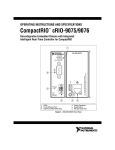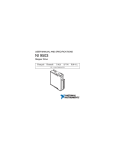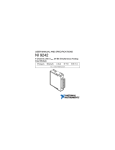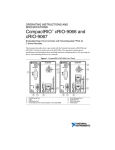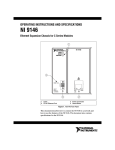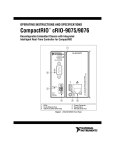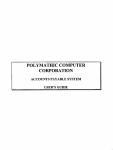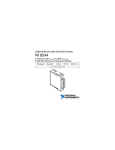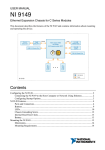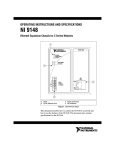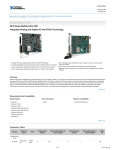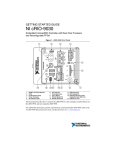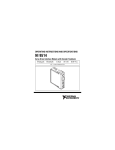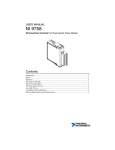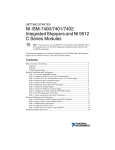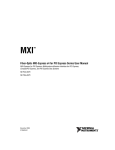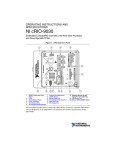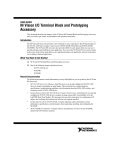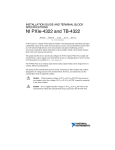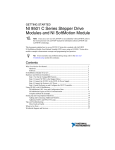Download NI 9155 Operating Instructions and Specifications
Transcript
OPERATING INSTRUCTIONS AND SPECIFICATIONS NI 9155 Reconfigurable Embedded Chassis with Integrated MXI-Express (x1) 1 2 NI 9155 MXI-Express RIO POWER POWER USER FPGA1 FPGA USER FPGA2 FPGA USER FPGA3 FPGA OFF 6 C V2 LINK 3 DOWNSTREAM V1 LINK UPSTREAM STREAM INPU INPUT 9-30 V 25W MAX MA NO FPGA APP AP USER FPGA1 FPGA USER FPGA2 FPGA USER FPGA3 FPGA 4 C 5 1 2 3 LEDs Upstream Port MXI-Express LINK LEDs 4 5 6 Downstream Port Power Connector DIP Switches Figure 1. NI 9155 Front Panel This document describes how to connect the NI 9155 to a MXI-Express host and one or more other chassis, and how to use the features of the NI 9155. This document also contains specifications for the NI 9155. This document refers inclusively to all reconfigurable embedded chassis with integrated MXI-Express (x1), such as the NI 9154, NI 9155, NI 9157, and NI 9159, as the NI 915x. Safety Guidelines Operate the NI 9155 only as described in these operating instructions. Safety Guidelines for Hazardous Locations The NI 9155 is suitable for use in Class I, Division 2, Groups A, B, C, D, T4 hazardous locations; Class 1, Zone 2, AEx nA IIC T4 and Ex nA IIC T4 hazardous locations; and nonhazardous locations only. Follow these guidelines if you are installing the NI 9155 in a potentially explosive environment. Not following these guidelines may result in serious injury or death. Caution Do not disconnect the power supply wires and connectors from the controller unless power has been switched off. Caution Substitution of components may impair suitability for Class I, Division 2. Caution For Zone 2 applications, install the system in an enclosure rated to at least IP 54 as defined by IEC 60529 and EN 60529. Special Conditions for Hazardous Locations Use in Europe Some chassis have been evaluated as Ex nA IIC T4 Gc equipment under DEMKO Certificate No. 12 ATEX 1202658X. Each such chassis is marked II 3G and is suitable for use in Zone 2 hazardous locations, in ambient temperatures of 0 ≤ Ta ≤ 55 °C. Provision shall be made to prevent the rated voltage being exceeded by the transient disturbances of more than 140% of the peak rated voltage. Caution The system shall be mounted in an ATEX certified enclosure with a minimum ingress protection rating of at least IP54 as defined in IEC/EN 60529 and used in an environment of not more than pollution degree 2. Caution Caution The enclosure must have a door or cover accessible only by the use of a tool. Electromagnetic Compatibility Guidelines This product was tested and complies with the regulatory requirements and limits for electromagnetic compatibility (EMC) stated in the product specifications. These requirements and limits provide reasonable NI 9155 Operating Instructions and Specifications 2 ni.com protection against harmful interference when the product is operated in the intended operational electromagnetic environment. This product is intended for use in industrial locations. However, harmful interference may occur in some installations, when the product is connected to a peripheral device or test object, or if the product is used in residential or commercial areas. To minimize interference with radio and television reception and prevent unacceptable performance degradation, install and use this product in strict accordance with the instructions in the product documentation. Furthermore, any modifications to the product not expressly approved by National Instruments could void your authority to operate it under your local regulatory rules. Caution To ensure the specified EMC performance, operate this product only with shielded cables and accessories. Special Guidelines for Marine Applications Some products are Lloyd’s Register (LR) Type Approved for marine (shipboard) applications. To verify Lloyd’s Register certification for a product, visit ni.com/certification and search for the LR certificate, or look for the Lloyd’s Register mark on the product label. Caution In order to meet the EMC requirements for marine applications, install the product in a shielded enclosure with shielded and/or filtered power and input/output ports. In addition, take precautions when designing, selecting, and installing measurement probes and cables to ensure that the desired EMC performance is attained. What You Need to Install the NI 9155 ❑ NI 9155 reconfigurable embedded chassis with integrated MXI-Express (x1) ❑ One of the following MXI-Express (x1) host systems – PXI system with MXI-Express device installed – PC with MXI-Express PCI or PCIe device installed – NI Industrial Controller – NI cRIO-9081/9082 integrated system The NI 9155 requires a host system with a PCI Express clock that complies with the PCI Express Specification. The NI 9155 may not be compatible with systems using noncompliant clocks, particularly clocks with peak frequencies higher than 100 MHz. For Note © National Instruments 3 NI 9155 Operating Instructions and Specifications more information about PCI Express clock compatibility with the NI 9155, go to ni.com/ info and enter the Info Code 915xclock. ❑ C Series I/O modules ❑ MXI-Express (x1) cable(s) up to 7 m long ❑ DIN rail mount kit (for DIN rail mounting only) ❑ Two M4 or number 8 panhead screws (for mounting the chassis without one of the listed mounting kits) ❑ Number 2 Phillips screwdriver ❑ Power supply ❑ MXI-Express (x1) for PXI Express User Manual Notes Visit ni.com/info and enter the Info Code rdsoftwareversion to determine which software you need to use the NI 9155. Mounting the NI 9155 You can mount the chassis horizontally on a flat, vertical, metallic surface such as a panel or wall. The maximum allowable ambient temperature for operation in this kind of mounting configuration is 55 °C. You can also mount the chassis on a DIN rail, on a desktop, or in a rack. However, only panel or wall mounting as described in this document enables operation at the maximum allowable ambient temperature. Any other mounting configuration can also affect the typical accuracy of modules in the chassis. Figure 2 shows the chassis mounted horizontally. NI 9155 Up Figure 2. NI 9155 Mounted Horizontally Note For more information about how different mounting configurations can cause temperature derating, go to ni.com/info and enter the Info Code criomounting. NI 9155 Operating Instructions and Specifications 4 ni.com Note For more information about typical accuracy specifications for modules, go to ni.com/info and enter the Info Code criotypical. Measure the ambient temperature at each side of the chassis, 63.5 mm (2.5 in.) from the side and 50.8 mm (2 in.) forward from the rear of the chassis, as shown in Figure 3. Note Your installation must meet the following requirements for space and cabling clearance: Caution • Allow 50.8 mm (2 in.) on the top and the bottom of the chassis for air circulation. • Allow 50.8 mm (2 in.) in front of modules for cabling clearance for common connectors, such as the 10-terminal, detachable screw terminal connector, as shown in Figure 3. For information about the minimum cabling clearance for C Series modules with other connector types, go to ni.com/info and enter the Info Code rdcrioconn. Note 52.5 mm (2.07 in.) 1 50.8 mm (2.00 in.) 29.1 mm (1.14 in.) 63.5 mm (2.50 in.) 1 89.4 mm (3.52 in.) 46.0 mm (1.81 in.) 264.3 mm (10.41 in.) 1 50.8 mm (2.00 in.) 63.5 mm (2.50 in.) Measure ambient temperature here. Figure 3. NI 9155, Bottom View with Dimensions Cooling Outline 50.8 mm (2.00 in.) 165.1 mm (6.50 in.) 19.0 mm (0.75 in.) NI 9155 1 36.4 mm (1.43 in.) 88.1 mm (3.47 in.) 51.7 mm (2.04 in.) 3.5 mm (0.14 in.) Cooling Outline 50.8 mm (2.00 in.) 1 Chassis Grounding Screw Figure 4. NI 9155, Front View with Dimensions © National Instruments 5 NI 9155 Operating Instructions and Specifications 74.6 mm (2.94 in.) 50.8 mm (2.00 in.) 63.1 mm (2.48 in.) 44.1 mm (1.73 in.) 25.0 mm (0.98 in.) Figure 5. NI 9155, Side View with Dimensions For more information about the dimensions of the system, including detailed dimensional drawings, go to ni.com/dimensions. Note For more information about mounting the chassis in environments with high shock and vibration, go to ni.com/info and enter the Info Code criomounting. Note Caution Make sure that no I/O modules are in the chassis before mounting it. Mounting the Chassis Directly on a Flat Surface Using the Mounting Holes For environments with high shock and vibration, National Instruments requires mounting the chassis directly on a flat, rigid surface using the mounting holes in the chassis. Complete the following steps to mount the chassis: 1. Use the dimensions shown in Figure 4 to prepare the surface for mounting the chassis. 2. Align the chassis on the surface. 3. Fasten the chassis to the surface using two M4 or number 8 screws, as shown in Figure 6. National Instruments does not provide these screws with the chassis. NI 9155 Operating Instructions and Specifications 6 ni.com NI 9155 Figure 6. Mounting the NI 9155 Directly on a Flat Surface Caution Make sure that no I/O modules are in the chassis before removing it from the surface. Mounting the Chassis on a DIN Rail Using the NI 9915 DIN Rail Mount Kit Complete the following steps to mount the chassis on a DIN rail using the NI 9915 DIN rail mount kit. 1. Fasten the DIN rail clip to the chassis using a number 2 Phillips screwdriver and two M4 × 50 screws. National Instruments provides these screws with the DIN rail mount kit. Tighten the screws to a maximum torque of 1.3 N ⋅ m (11.5 lb ⋅ in.). Figure 7. Installing the DIN Rail Clip on the NI 9155 © National Instruments 7 NI 9155 Operating Instructions and Specifications 2. Insert one edge of the DIN rail into the deeper opening of the DIN rail clip, as shown in Figure 8. 1 2 3 1 DIN Rail Clip 2 DIN Rail 3 DIN Rail Spring Figure 8. Attaching the DIN Rail Clip to the DIN Rail 3. Press down firmly on the chassis to compress the spring until the clip locks in place on the DIN rail. Installing C Series I/O Modules in the Chassis Figure 9 shows the mechanical dimensions of C Series I/O modules. 88.1 mm (3.47 in.) 70.7 mm (2.78 in.) 22.9 mm (0.90 in.) Figure 9. C Series I/O Module, Front and Side View with Dimensions NI 9155 Operating Instructions and Specifications 8 ni.com Complete the following steps to install a C Series I/O module in the chassis. 1. Make sure that no I/O-side power is connected to the I/O module. If the system is in a nonhazardous location, the chassis power can be on when you install I/O modules. 2. Align the I/O module with an I/O module slot in the chassis as shown in Figure 10. The module slots are labeled 1 to 8, left to right. 1 2 1 Insertion Groove 2 Latch Figure 10. Installing an I/O Module in the Chassis © National Instruments 3. Squeeze the latches and insert the I/O module into the module slot. 4. Press firmly on the connector side of the I/O module until the latches lock the I/O module into place. 5. Repeat these steps to install additional I/O modules. 9 NI 9155 Operating Instructions and Specifications Removing I/O Modules from the Chassis Complete the following steps to remove a C Series I/O module from the chassis. 1. Make sure that no I/O-side power is connected to the I/O module. If the system is in a nonhazardous location, the chassis power can be on when you remove I/O modules. 2. Squeeze the latches on both sides of the module and pull the module out of the chassis. Connecting the Chassis to Earth Ground You must connect the chassis grounding screw to earth ground. Refer to Figure 4 for the location of the grounding screw. Complete the following steps to connect to earth ground: 1. Attach a ring lug to a 2.05 mm diameter (12 AWG) or larger wire. 2. Remove the grounding screw from the grounding terminal on the right side of the chassis. 3. Attach the ring lug to the grounding terminal. 4. Tighten the grounding screw to 0.5 N · m (4.4 lb · in.) of torque. 5. Attach the other end of the wire to earth ground using a method appropriate for the application. If you use shielded cabling to connect to a C Series I/O module with a plastic connector, you must attach the cable shield to the chassis grounding terminal using 1.3 mm diameter (16 AWG) or larger wire. Use shorter wire for better EMC performance. Note For more information about earth ground connections, go to ni.com/info and enter the Info Code earthground. Wiring Power to the Chassis The NI 9155 requires an external power supply that meets the specifications in the Power Requirements section. The NI 9155 filters and regulates the supplied power and provides power for all of the I/O modules. You must connect a power supply to at least one pair of V and C terminals. Optionally, you can connect a second power supply to the other pair of V and C terminals. The chassis draws power from the power supply with the higher voltage. The NI 9155 has one layer of reversed-voltage protection. Complete the following steps to connect a power supply to the chassis. NI 9155 Operating Instructions and Specifications 10 ni.com 1. Connect the positive lead of the power supply to the V1 or V2 terminal of the COMBICON connector shipped with the NI 9155. 2. Connect the negative lead of the power supply to one of the C terminals of the COMBICON connector. 3. Optionally, you can connect the positive lead of another power supply to the other V terminal and the negative lead to one of the C terminals. 4. Install the COMBICON connector on the front panel of the NI 9155. Caution To ensure the specified EMC performance, do not connect the power input to a DC mains supply or to any supply requiring a connecting cable longer than 3 m (10 ft). A DC mains supply is a local DC electricity supply network in the infrastructure of a certain site or building. Note The chassis draws power from either V1 or V2 depending on which terminal has a higher voltage. It does not draw power from both terminals. The chassis switches between V1 and V2 without affecting operation. If you prefer for the chassis to draw power from one power supply, you must ensure that the voltage of that power supply, measured at the chassis power connector, is at least 500 mV higher than the voltage of the other power supply. Note Caution The C terminals are internally connected to each other. If you use two power supplies, make sure that they share a common ground. Caution The C terminals are internally connected to the body of the chassis to prevent a faulty ground connection from causing the chassis ground to float. If you reverse the input voltage, the positive input voltage is connected directly to the chassis. The chassis has built-in reversed-voltage protection, but reversed voltage can damage connected peripherals if the chassis ground is not reliably connected to earth ground. Caution Do not tighten or loosen the terminal screws on the power connector while the power connector is plugged into the chassis or while the power supply is on. Connecting One or More NI 915x Chassis to the MXI-Express Host System Complete the following steps to connect one or more NI 915x chassis to a MXI-Express host system. © National Instruments 1. Make sure the MXI-Express host system is set up and configured as described in the MXI-Express (x1) for PXI Express User Manual. 2. If the MXI-Express host system is powered up, power it down. 3. If the NI 915x is powered up, power it down. 11 NI 9155 Operating Instructions and Specifications 4. Use a MXI-Express cable to connect the MXI-Express host system to the Upstream port of the first NI 915x in the chain. 5. Use a MXI-Express cable to connect the Downstream port of the first NI 915x to the Upstream port of the next NI 915x in the chain. The maximum number of NI 915x chassis in a chain depends on the system configuration. For example, a PXI system with an NI PXI-8196 controller can support four chassis per chain. Different types of systems may support more or fewer chassis per chain. For more information about how different system configurations can affect the maximum number of chassis in a chain, go to ni.com/info and enter the Info Code 915xchain. Note 6. Power up all of the connected NI 915x chassis. 7. Power up the MXI-Express host system. Caution All connected NI 915x chassis must have power connected before the host system is powered up. The BIOS and OS of the host system must detect all bus segments on the chassis side in order to configure the PCI hierarchy. Powering connected chassis up or down while the host system is running can cause system hangs and data corruption. Caution Do not remove MXI-Express cables while power is connected. Doing so can cause hangs or application errors. If a cable becomes unplugged, plug it back in and reboot. Chassis Powerup Options Table 1 lists the reset options available for the NI 9155. These options determine how the chassis behaves when it is powered on in various conditions. Use the RIO Device Setup utility to select reset options. Access the RIO Device Setup utility by selecting Start»All Programs»National Instruments»NI-RIO»RIO Device Setup. Table 1. Chassis Powerup Options Powerup Option Behavior Do Not Autoload VI Does not load the FPGA bit stream from flash memory. Autoload VI on device powerup Loads the FPGA bit stream from flash memory to the FPGA when the chassis powers on. If you want the NI 9155 to autoload and run a VI at powerup, you must also configure the VI to autoload before you compile it. For more information about autoloading VIs, refer to LabVIEW FPGA Module Help. NI 9155 Operating Instructions and Specifications 12 ni.com Checking MXI-Express LINK LEDs for Status After powering on the chassis and host system, check the MXI-Express LINK LEDs to ensure that all connected systems are linked and communicating properly. The MXI-Express LINK LEDs of the NI 9155 indicate the following: Table 2. NI 9155 MXI-Express LINK LED Indications LINK LED Appearance Meaning Off Chassis power is off. Solid yellow Link is not established. Solid green Link is established. Blinking yellow PCI Express clock is incompatible with NI 9155. Note For information about PCI Express clock compatibility with the NI 9155, go to ni.com/info and enter the Info Code 915xclock. Powering Down the MXI-Express System Always power down the host system before powering down any connected NI 9155 chassis. When the host system is powered down, the order in which connected NI 9155 chassis are powered down is not important. Configuring DIP Switches OFF NO FPGA APP USER FPGA1 USER FPGA2 USER FPGA3 Figure 11. DIP Switches All of the DIP switches are in the OFF position when the chassis is shipped from National Instruments. © National Instruments 13 NI 9155 Operating Instructions and Specifications NO FPGA APP Switch Push the NO FPGA APP switch to the ON position to prevent a LabVIEW FPGA application from loading at startup. The NO FPGA APP switch overrides the chassis powerup options described in the Chassis Powerup Options section. After startup you can download to the FPGA from software regardless of switch position. USER FPGA Switches You can define the USER FPGA switches for your application. Use the LabVIEW FPGA Module and NI-RIO software to define the USER FPGA switches to meet the needs of your application. Refer to LabVIEW Help for information about programming these switches. Understanding LED Indications POWER P USER FPGA1 USER FPGA2 USER FPGA3 Figure 12. NI 9155 LEDs POWER LED The POWER LED is lit while the NI 9155 is powered on. This LED is a bi-color LED. When the chassis is powered from V1, the POWER LED is lit green. When the chassis is powered from V2, the POWER LED is lit yellow. USER FPGA LEDs You can use the bi-color, yellow and green USER FPGA LEDs to help debug your application or easily retrieve application status. Use the LabVIEW FPGA Module and NI-RIO software to define the USER FPGA LEDs to meet the needs of your application. Refer to LabVIEW Help for information about programming these LEDs. NI 9155 Operating Instructions and Specifications 14 ni.com Specifications The following specifications are typical for the 0 to 55 °C operating temperature range unless otherwise noted. These specifications are for the NI 9155 reconfigurable embedded chassis only. For I/O module specifications, refer to the module operating instructions. MXI-Express Maximum cable length........................... 7 m Reconfigurable FPGA FPGA type.............................................. Virtex-5 LX85 Number of flip-flops .............................. 51,840 Number of 6-input LUTs ....................... 51,840 Number of DSP48 slices ........................ 48 Available block RAM ............................ 3,456 kbits Timebases............................................... 40, 80, 120, 160, or 200 MHz Accuracy ......................................... ±100 ppm (max) Frequency dependent jitter (peak-to-peak) 40 MHz .................................... 250 ps 80 MHz .................................... 422 ps 120 MHz .................................. 422 ps 160 MHz .................................. 402 ps 200 MHz .................................. 402 ps Power Requirements Voltage input range................................ 9 to 30 VDC Maximum power input........................... 30 W Maximum power consumption With no I/O modules....................... 14.6 W With 8 I/O modules......................... 23.0 W Note The power consumption specifications in this document are maximum values for a LabVIEW FPGA application compiled at 80 MHz. Your application power requirements may be different. To calculate the power requirements of the NI 9155, add the power consumption/dissipation for the chassis and the I/O modules you are using. Keep in mind © National Instruments 15 NI 9155 Operating Instructions and Specifications that the resulting total power consumption is a maximum value and that the NI 9155 may require less power in your application. For more information about the I/O module power requirements, refer to the module operating instructions. Physical Characteristics If you need to clean the chassis, wipe it with a dry towel. Screw-terminal wiring ............................ 1.02 mm diameter (18 AWG) to 2.05 mm diameter (12 AWG) copper conductor wire with 10 mm (0.39 in.) of insulation stripped from the end Torque for screw terminals.....................0.5 to 0.6 N · m (4.4 to 5.3 lb · in.) Chassis weight ........................................1,600 g (56.4 oz) Environmental Operating temperature (IEC-60068-2-1 and IEC-60068-2-2) .....0 °C to 55 °C Refer to the mounting instructions in the Mounting the NI 9155 section of this document. Failure to follow the mounting instructions in that section can cause temperature derating. For more information about mounting configurations and temperature derating, go to ni.com/info and enter the Info Code criomounting. Note Storage temperature (IEC-60068-2-1 and IEC-60068-2-2) .....-40 °C to 85 °C Ingress protection ...................................IP 40 Operating humidity (IEC-60068-2-56)...10 to 90% RH, noncondensing Storage humidity (IEC-60068-2-56) ......5 to 95% RH, noncondensing Maximum altitude...................................2,000 m Pollution Degree (IEC 60664) ................2 Indoor use only NI 9155 Operating Instructions and Specifications 16 ni.com Shock and Vibration To meet these specifications, you must mount the chassis directly on a flat, rigid surface as described in the Mounting the Chassis Directly on a Flat Surface Using the Mounting Holes section, affix ferrules to the ends of the terminal lines, and provide strain relief for all cables. Operating vibration, random (IEC 60068-2-64)...................... 5 grms, 10 to 500 Hz Operating vibration, sinusoidal (IEC 60068-2-6).................... 5 g, 10 to 500 Hz Operating shock (IEC 60068-2-27)........ 30 g, 11 ms half sine, 50 g, 3 ms half sine, 18 shocks at 6 orientations Safety Safety Voltages Connect only voltages that are within these limits. V-to-C .................................................... 30 VDC max, Measurement Category I Measurement Category I is for measurements performed on circuits not directly connected to the electrical distribution system referred to as MAINS voltage. MAINS is a hazardous live electrical supply system that powers equipment. This category is for measurements of voltages from specially protected secondary circuits. Such voltage measurements include signal levels, special equipment, limited-energy parts of equipment, circuits powered by regulated low-voltage sources, and electronics. Caution Do not connect to signals or use for measurements within Measurement Categories II, III, or IV. Electromagnetic Compatibility This product meets the requirements of the following EMC standards for electrical equipment for measurement, control, and laboratory use: © National Instruments • EN 61326-1 (IEC 61326-1): Class A emissions; Industrial immunity • EN 55011 (CISPR 11): Group 1, Class A emissions • AS/NZS CISPR 11: Group 1, Class A emissions • FCC 47 CFR Part 15B: Class A emissions • ICES-001: Class A emissions 17 NI 9155 Operating Instructions and Specifications In the United States (per FCC 47 CFR), Class A equipment is intended for use in commercial, light-industrial, and heavy-industrial locations. In Europe, Canada, Australia, and New Zealand (per CISPR 11), Class A equipment is intended for use only in heavy-industrial locations. Note Group 1 equipment (per CISPR 11) is any industrial, scientific, or medical equipment that does not intentionally generate radio-frequency energy for the treatment of material or inspection/analysis purposes. Note Note For EMC declarations and certifications, and additional information, refer to the Online Product Certification section. CE Compliance This product meets the essential requirements of applicable European Directives as follows: • 2006/95/EC; Low-Voltage Directive (safety) • 2004/108/EC; Electromagnetic Compatibility Directive (EMC) Online Product Certification Refer to Declaration of Conformity (DoC) for this product for additional regulatory compliance information. To obtain product certifications and the DoC for this product, visit ni.com/certification, search by model number or product line, and click the appropriate link in the Certification column. Environmental Management NI is committed to designing and manufacturing products in an environmentally responsible manner. NI recognizes that eliminating certain hazardous substances from our products is beneficial to the environment and to NI customers. For additional environmental information, refer to the Minimize Our Environmental Impact web page at ni.com/environment. This page contains the environmental regulations and directives with which NI complies, as well as other environmental information not included in this document. NI 9155 Operating Instructions and Specifications 18 ni.com Waste Electrical and Electronic Equipment (WEEE) EU Customers At the end of the product life cycle, all products must be sent to a WEEE recycling center. For more information about WEEE recycling centers, National Instruments WEEE initiatives, and compliance with WEEE Directive 2002/96/EC on Waste Electrical and Electronic Equipment, visit ni.com/environment/weee. ⬉ᄤֵᙃѻક∵ᶧࠊㅵ⧚ࡲ⊩ ˄Ё RoHS˅ Ёᅶ᠋ National Instruments ヺড়Ё⬉ᄤֵᙃѻકЁ䰤ࠊՓ⫼ᶤѯ᳝ᆇ⠽䋼ᣛҸ (RoHS)DŽ ݇Ѣ National Instruments Ё RoHS ড়㾘ᗻֵᙃˈ䇋ⱏᔩ ni.com/environment/rohs_chinaDŽ (For information about China RoHS compliance, go to ni.com/environment/rohs_china.) Hazardous Locations U.S. (UL) ................................................Class I, Division 2, Groups A, B, C, D, T4; Class I, Zone 2, AEx nA IIC T4 Canada (C-UL) .......................................Class I, Division 2, Groups A, B, C, D, T4; Class I, Zone 2, Ex nA IIC T4 Europe (DEMKO) ..................................Ex nA IIC T4 Gc Where to Go for Support National Instruments corporate headquarters is located at 11500 North Mopac Expressway, Austin, Texas, 78759-3504. National Instruments also has offices located around the world to help address your support needs. For telephone support in the United States, create a service request at ni.com/support and follow the calling instructions or dial 512 795 8248. For telephone support outside the United States, visit the Worldwide Offices section of ni.com/niglobal to access the branch office Web sites, which provide up-to-date contact information, support phone numbers, email addresses, and current events. © National Instruments 19 NI 9155 Operating Instructions and Specifications LabVIEW, National Instruments, NI, ni.com, the National Instruments corporate logo, and the Eagle logo are trademarks of National Instruments Corporation. Refer to the Trademark Information at ni.com/trademarks for other National Instruments trademarks. Other product and company names mentioned herein are trademarks or trade names of their respective companies. For patents covering National Instruments products/technology, refer to the appropriate location: Help»Patents in your software, the patents.txt file on your media, or the National Instruments Patent Notice at ni.com/patents. You can find information about end-user license agreements (EULAs) and third-party legal notices in the NI-RIO Device Drivers Readme. Refer to the Export Compliance Information at ni.com/legal/export-compliance for the National Instruments global trade compliance policy and how to obtain relevant HTS codes, ECCNs, and other import/export data. © 2012 National Instruments. All rights reserved. 375994A-01 Dec12





















